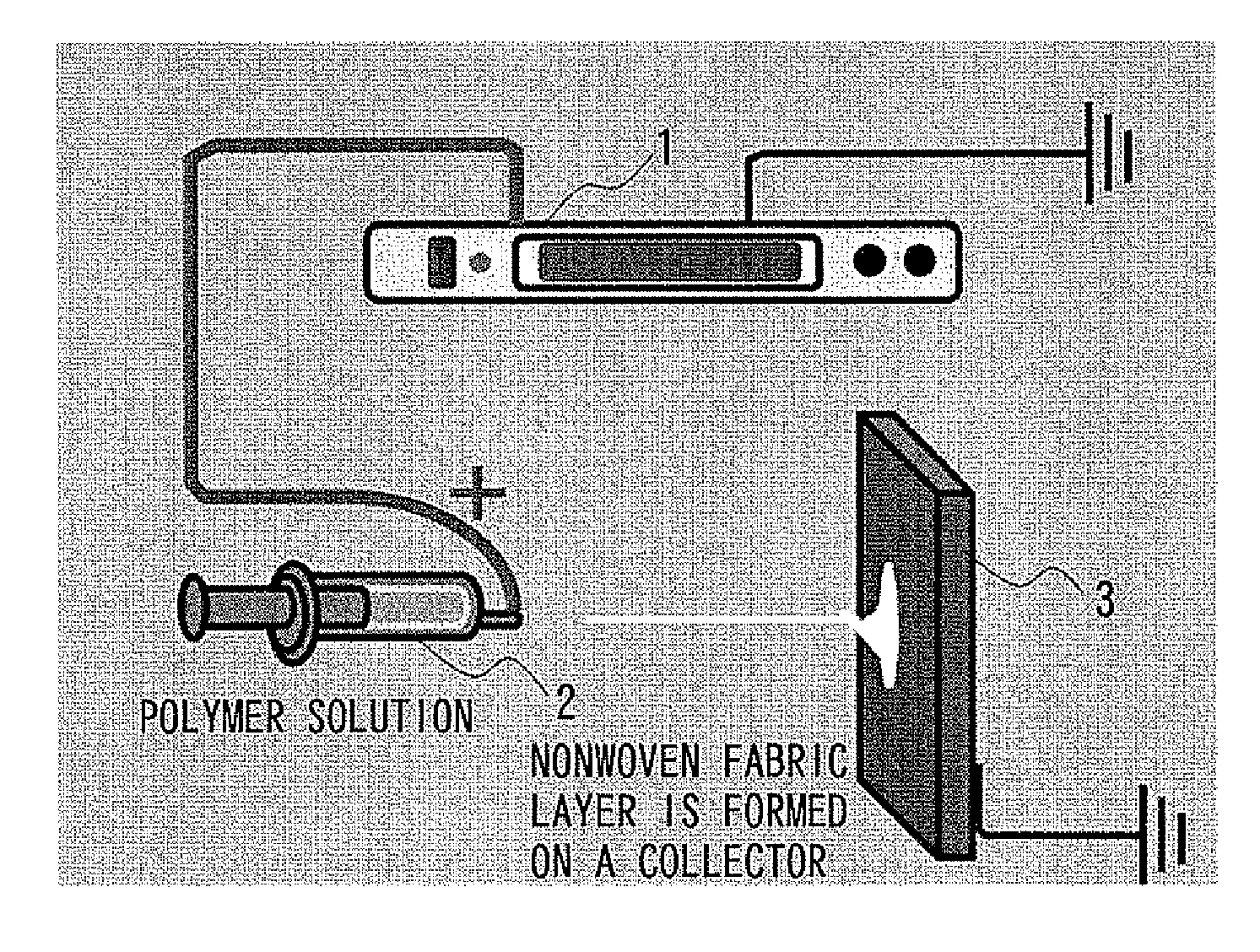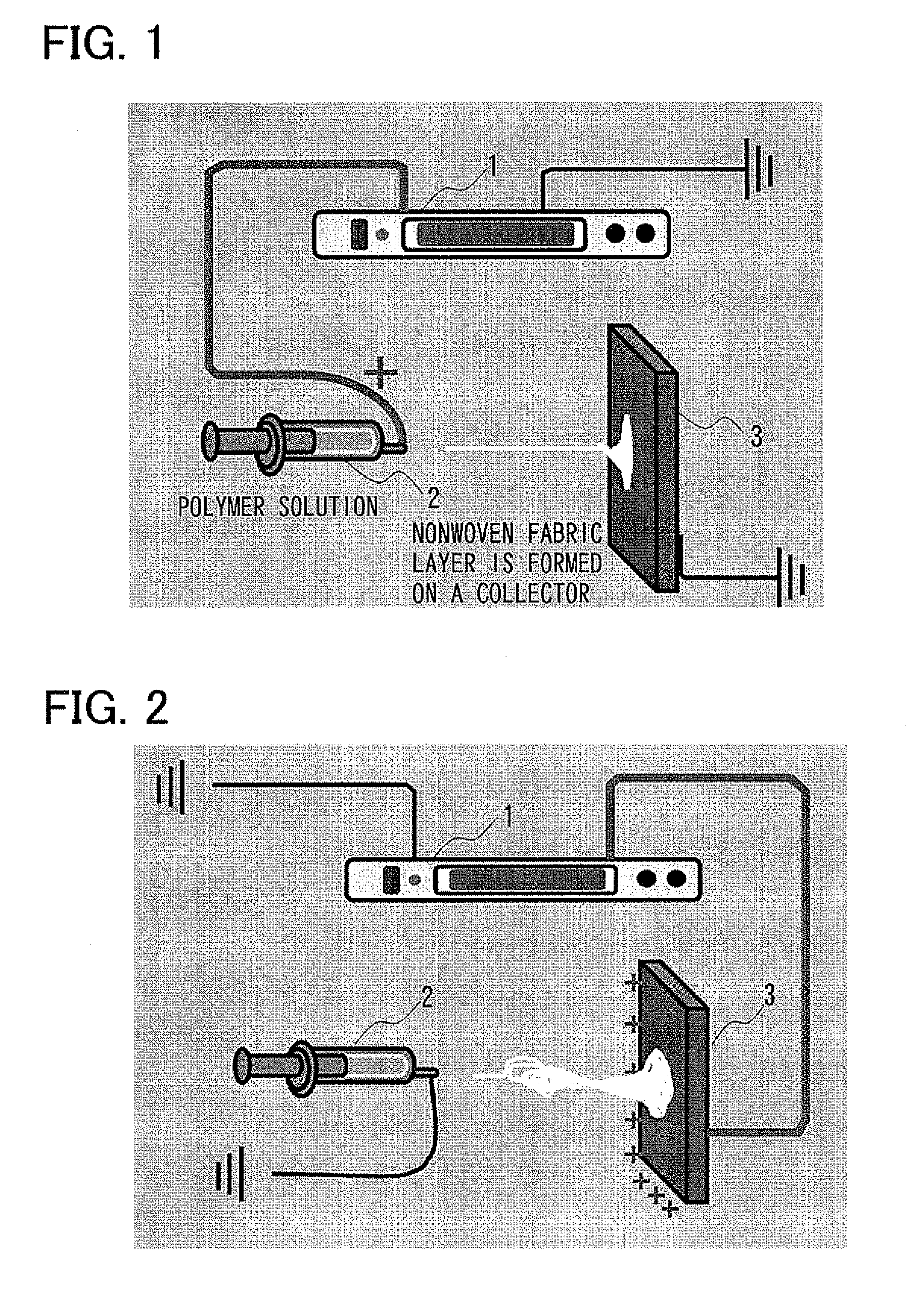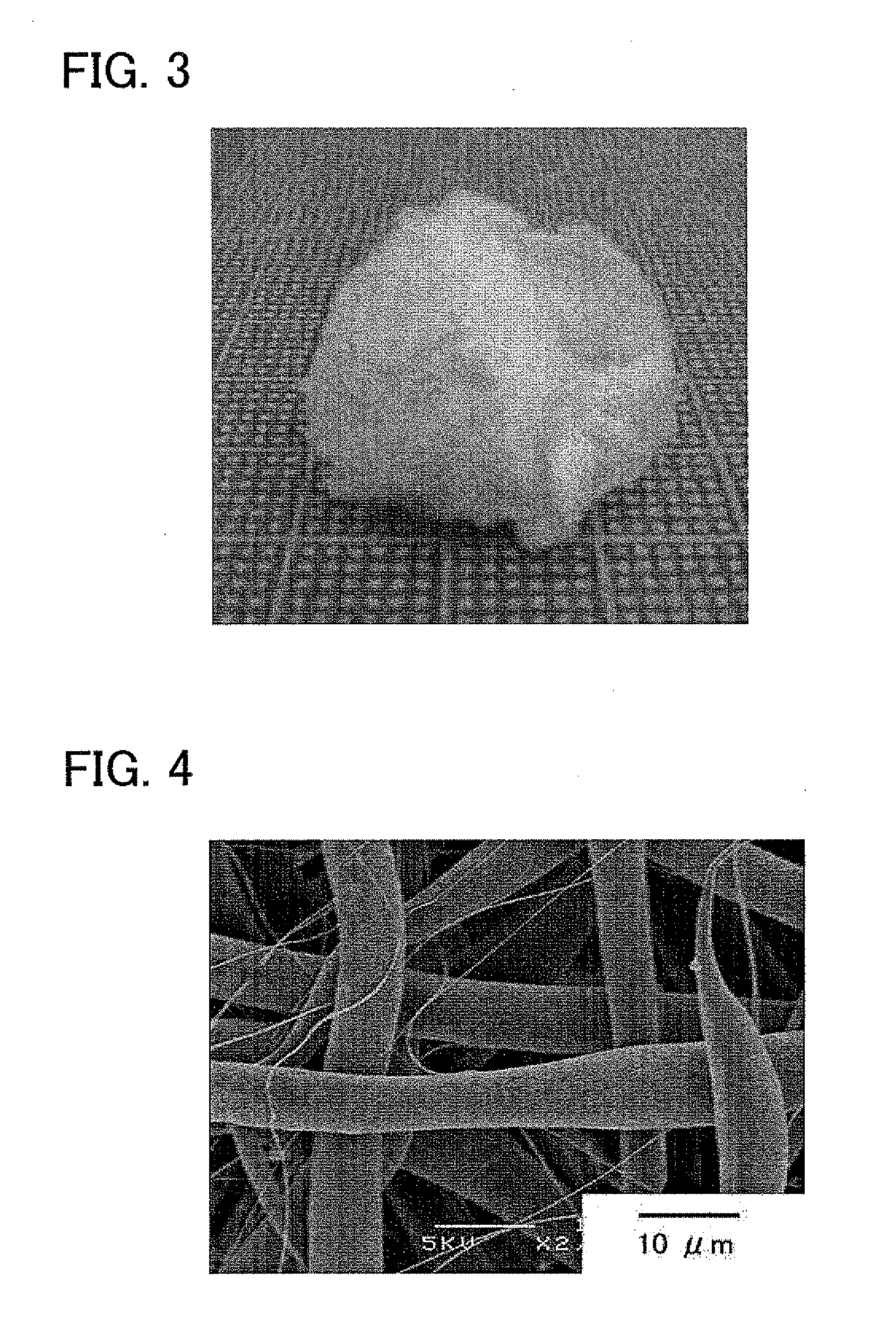[0034]The
spinning solution may be further combined with a
calcium carbonate to form a
slurry (spinning slurry). This helps the
speedup (acceleration) of the step of soaking the electrospun article in a
buffer solution being supersaturated with respect to hydroxyapatite to form an absorbable hydroxyapatite thereon. The absorbable hydroxyapatite helps to show higher initial cellular adhesion. The amount of the calciumcarbonate is possibly 60 percent by weight or less, because the
calcium carbonate, if added in an amount of more than 60 percent by weight, maybe difficult to mix with the solution to give a homogeneous slurry. However, the
calcium carbonate, if added in an amount less than 10 percent by weight, may not exhibit its advantageous effects remarkably. The solution or slurry may further include one or more inorganic substances which are
usable in vivo without problems. Examples of such inorganic substances include hydroxyapatite,
tricalcium phosphate, calcium
sulfate,
sodium phosphate,
sodium hydrogen phosphate, calcium
hydrogen phosphate,
octacalcium phosphate,
tetracalcium phosphate,
calcium pyrophosphate, and calcium
chloride.
[0035]The material for filling bone defects can also be a substance containing a biodegradable resin as a principal component and further containing or bearing a
siloxane. This substance is prepared by preparing
calcium carbonate microparticles bearing a
siloxane dispersed therein (Si—CaCO3) typically by the method described in Japanese Unexamined
Patent Application Publication (JP-A) No. 2008-100878; and mixing 60 percent by weight or less of the Si—CaCO3 microparticles with PLA. The amount of the Si—CaCO3 microparticles is preferably from 10 to 60 percent by weight relative to the PLA, as in the
calcium carbonate. To uniformly disperse themicroparticles, the substance is preferably prepared by kneading the PLA and Si—CaCO3 microparticles in predetermined proportions in a heating kneader to give a composite, and dissolving the composite in the
solvent to give a spinning solution.
[0036]According to a common
electrospinning technique with reference to FIG. 1, a charge is applied by a
voltage supply 1 to a
nozzle of a
syringe 2, namely, a positive charge is applied to a spinning solution; and the solution is slowly extruded from the tip of the
nozzle. At the time when the effect of
electric field becomes larger than the
surface tension, the solution is stretched into fibers, travels toward a collector 3 of an earth
electrode, reaches the collector 3 while evaporating the
solvent, and thereby forms a
thin layer of
nonwoven fabric of fibers. This technique, however, does not basically give a three-dimensional steric structure even if modifying spinning conditions such as the concentration of the spinning solution, the type of solvent contained in the solution, the supply speed of the solution, the spinning time, the applied
voltage, and the distance between the nozzle and the collector. This is because the residual solution and the resin deposited on the collector 3 are charged by themselves and repel with each other, and this impede the deposition in a thickness direction. In this connection, the fibrous resin derived from the solution deposits on the collector 3 while evaporating most of the solvent, but a trace amount of the solution deposits as intact on the collector 3.
[0037]In contrast, according to the, embodiment of the present invention with reference to FIG. 2, a three-dimensional steric structure can be formed by carrying out
electrospinning while grounding the nozzle of the
syringe 2 without applying a charge thereto, and, contrarily, applying a positive charge to the collector 3. According this technique, if a regular spinning solution is slowly extruded from the tip of the nozzle, the spinning solution falls as droplets, because the solution is not charged. However, when the spinning solution further contains a liquid, such as water, having a greater relative
dielectric constant than that of the biodegradable resin, the liquid is affected by the
electric field, and the spinning solution may be drawn toward the collector by the action of polarization. In this case, the spinning solution is not charged by itself and readily three-dimensionally deposits on the collector 3 without suffering from electrostatic repulsion. In this process, the liquid (solution) is divided to two or more strands and drawn from the nozzle of the syringe 2 toward the collector 3, and these strands are entangled to form a flocculent three-dimensional steric structure on the collector 3. To allow this phenomenon to occur, however, the spinning solution should have a somewhat low
viscosity. The spinning solution, if having an excessively high
viscosity, may not reach the collector 3 even when affected by the
electric field. Accordingly, the
diameter of the fibrous substance constituting the three-dimensional steric structure prepared according to the present embodiment is substantially controlled by the
viscosity of the spinning solution. When the spinning solution has a particularly low viscosity, the fibrous substance more easily deposits to form a three-dimensional steric structure and more easily has a smaller
fiber diameter. Typically, when the spinning solution is prepared by dissolving a PLA in
chloroform to give a solution and adding
ethanol and water thereto, the resulting fibrous substance has a
fiber diameter of 0.05 μm or more and less than 10 μm. It is acceptable to apply not a positive charge but a
negative charge to the collector 3, as long as the spinning solution is drawn toward the collector by the action of polarization.
[0038]The resulting three-dimensional steric structure is
cut into a piece of necessary size, and the
cut piece is soaked in a
buffer solution containing calcium ions and phosphate ions and being saturated with respect to hydroxyapatite to coat the surface of its fibrous skeleton with a hydroxyapatite easily. Examples of the
buffer solution for use herein include a
Tris buffer solution (pH 7.2 to 7.4) (SBF) containing ions in a concentration substantially equal to the inorganic
ion concentration in
human plasma; and a solution (1.5 SBF) containing ions in concentrations 1.5 times those of SBF. The 1.5 SBF is more advantageous, because the fibrous substance can be coated with a hydroxyapatite more rapidly.
[0039]According to the present embodiment, there is provided a flexible material for filling bone defects, which material has a three-dimensional steric structure including a fibrous substance, in which the fibrous substance contains a biodegradable resin, represented by a poly (
lactic acid) (PLA), as a principal component and further contains or bears a siloxane. There is also provided a filling material for bone-repairing, in which the surface of the fibrous substance constituting the three-dimensional steric structure is coated with a hydroxyapatite. The material surely including a communicating space for the entrance of cells and having improved fittability in the affected area can be easily prepared by adopting the technique for producing a
nonwoven fabric through electrospinning to the production of the three-dimensional steric structure. In addition, the
coating with an absorbable hydroxyapatite can be easily performed by soaking the electrospun article in a buffer solution being supersaturated with respect to hydroxyapatite, and the coated absorbable hydroxyapatite helps to provide higher initial cellular adhesion.
 Login to View More
Login to View More 


